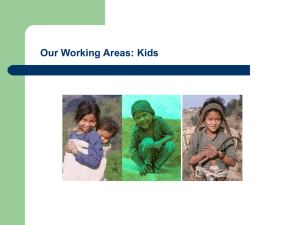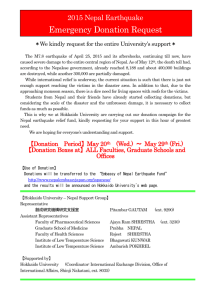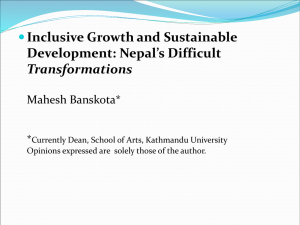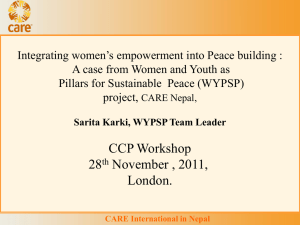Follesdal-2011-Nepal-IJMGR
advertisement
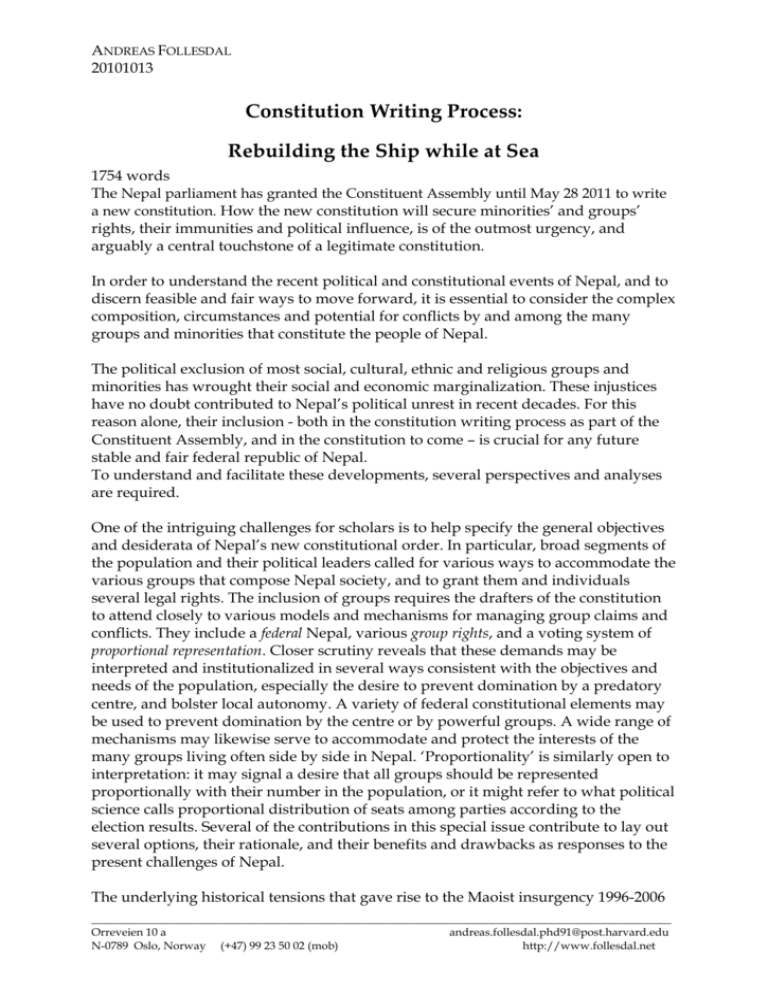
ANDREAS FOLLESDAL 20101013 Constitution Writing Process: Rebuilding the Ship while at Sea 1754 words The Nepal parliament has granted the Constituent Assembly until May 28 2011 to write a new constitution. How the new constitution will secure minorities’ and groups’ rights, their immunities and political influence, is of the outmost urgency, and arguably a central touchstone of a legitimate constitution. In order to understand the recent political and constitutional events of Nepal, and to discern feasible and fair ways to move forward, it is essential to consider the complex composition, circumstances and potential for conflicts by and among the many groups and minorities that constitute the people of Nepal. The political exclusion of most social, cultural, ethnic and religious groups and minorities has wrought their social and economic marginalization. These injustices have no doubt contributed to Nepal’s political unrest in recent decades. For this reason alone, their inclusion - both in the constitution writing process as part of the Constituent Assembly, and in the constitution to come – is crucial for any future stable and fair federal republic of Nepal. To understand and facilitate these developments, several perspectives and analyses are required. One of the intriguing challenges for scholars is to help specify the general objectives and desiderata of Nepal’s new constitutional order. In particular, broad segments of the population and their political leaders called for various ways to accommodate the various groups that compose Nepal society, and to grant them and individuals several legal rights. The inclusion of groups requires the drafters of the constitution to attend closely to various models and mechanisms for managing group claims and conflicts. They include a federal Nepal, various group rights, and a voting system of proportional representation. Closer scrutiny reveals that these demands may be interpreted and institutionalized in several ways consistent with the objectives and needs of the population, especially the desire to prevent domination by a predatory centre, and bolster local autonomy. A variety of federal constitutional elements may be used to prevent domination by the centre or by powerful groups. A wide range of mechanisms may likewise serve to accommodate and protect the interests of the many groups living often side by side in Nepal. ‘Proportionality’ is similarly open to interpretation: it may signal a desire that all groups should be represented proportionally with their number in the population, or it might refer to what political science calls proportional distribution of seats among parties according to the election results. Several of the contributions in this special issue contribute to lay out several options, their rationale, and their benefits and drawbacks as responses to the present challenges of Nepal. The underlying historical tensions that gave rise to the Maoist insurgency 1996-2006 ____________________________________________________________________________________________________ Orreveien 10 a andreas.follesdal.phd91@post.harvard.edu N-0789 Oslo, Norway (+47) 99 23 50 02 (mob) http://www.follesdal.net underscore the perplexing number of cleavages among the people of Nepal, and the many kinds of overlapping groups that must be secured representation in the electoral system. The future system of representation must accommodate groups that are divided along distinctions of caste, ethnicity, language, and to some degree, religion; with a very large number of indigenous groups – (Adivasi) Janajatis – to boot. Their long experience of political marginalization was based on a caste ideology consonant with the Hindu nature of the state, bolstered by nation building processes that downplayed the heterogeneity of Nepal’s peoples with their many religions, cultures and languages. This heterogeneity fostered several forms of multidimensional discrimination for those doubly disadvantaged such as Janajati women. Earlier constitutional reforms including that of 1990 largely failed to alleviate the drastic economic and social inequalities, promises and constitutional statements notwithstanding. The Maoist insurgents successfully appealed to the grievances wrought by these multiple cleavages, and the issue of excluded groups has since remained center stage for the constitution writing agenda. Indeed, in her succinct overview of this historical, social and political background, Seira Tamang argues that the Maoists and the Seven Party Alliance (SPA) may even have missed the impact of the identity politics they helped fuel and unleash. One reason may be the mobilizing power of minority and group rights possibly recognized in a future constitution. Such hopes may well have fostered ‘ethnic entrepreneurs’ in Nepal, as witnessed elsewhere during times of constitutional upheaval. The memories of oppression past have fostered understandable broad mistrust of politicians, parties and other elites. The need to create institutions that foster trust and a vibrant civic community adds further demands on the Constituent Assembly – which was and is already burdened by the need to create necessarily complex federal mechanisms in the new Nepal. The 2007 Interim Constitution of Nepal came at the end of two years of negotiations between the SPA and the Maoists. It laid out how a Constituent Assembly (CA) should be elected, and some components of how the constitution should be drafted. The details of how to elect members to representative bodies must wait for the new constitution. The election to CA combined a First-Past-the-Post system; a system of “proportional representation” that reflected the various groups’ proportion of the population; and personal nominations by the interim Council of Ministers. The draft rules were changed from ensuring minimum representation by various groups to specify exact quotas for all groups, and 50% of each gender. A central feature of these rules was to allocate specific quotas to all groups, not minimum thresholds only to the hitherto politically marginalized groups; another challenge concerned the overlapping nature of group membership: Each representative might have several relevant group identities. Comparisons with other states that have experienced deep cleavages and conflicts among population groups indicate that there are several models and mechanisms that a constitution can employ, to enhance the future resolution, -2- management and avoidance of deep conflicts among groups. Participants in the discussions in Nepal have drawn on several of these lessons in suggestions for how to cope with and even celebrate the diversity of the people and peoples of Nepal. This is particularly crucial since the conflict arose from exploitation of regions and sectors of society, and a main objective of the constitution must be to engender reconciliation and secure social justice and inclusion of previously marginalised groups. Yash Ghai provides a comprehensive overview of constitutional arrangements of multi-ethnic states, ranging from those that tend to disregard ethnic or cultural differences in the name of equal treatment, to those that endorse ‘identity politics’ and seek to distribute political authority and immunity among the various populations that jointly constitute the people. He also discusses the achievements and challenges of the Interim Constitution of 2007, especially ways to balance the need for integrity of Nepal with the legitimate concerns and interests of various marginalized groups. He is concerned to identify several constitutional options that may promote national unity and still recognize and maintain diversity. These mechanisms range from forms of political representation, to language policies, religious policies, affirmative action and federalism. One of the most difficult tasks of the Nepal Constituent Assembly concerns how to put into the constitution the idea and mechanisms of federalism in ways that are faithful to the best interests of the Nepal people. Two features of the Nepal demographics are especially noteworthy: there are very many different, often overlapping groups, each of which must be accommodated fairly. And members of these groups very often live side by side on the same territory. There are at least four forms of federal elements that may be used, each of which has benefits and drawbacks peculiar to the circumstances Two of the four are territorial: Constitutional – an entrenched split of powers - and Political: decentralised autonomy. Two are non-territorial: Minority Rights, and Minority Representation in common decision making bodies. Andreas Follesdal draws on other states’ experiences to elaborate some of these arguments and lessons for how human rights protections combined with federal elements might best serve to prevent future domination, especially by the centres, over these many ethnic groups and castes. Kåre Vollan discusses the results of these rules and the changes, aimed to secure a broader representation in the CA. He concludes that while some of the excluded groups such as Dalits and women did secure better representation than they would have without a quota system in place, for other groups the quotas largely benefitted those who would anyway be represented. Thus the voting rules, their complexity notwithstanding, largely fell short of their objective, to include hitherto excluded groups. Indeed, the complicated quota rules may themselves have hindered comprehension by voters and parties alike. Vollan then considers the various proposals for the future electoral system, assessing them against 10 desirable qualities including proportionality, inclusiveness, simplicity and transparency, promoting integration and reconciliation, and that command general acceptance. He proposes some developments that can better ensure representation for small excluded groups, and that may secure that the truly excluded segments of various -3- groups are represented better. He inter alia suggests some affirmative action measures, and to replace exact quotas by minimum quotas only for excluded groups. Peris Jones and Malcolm Langford explore some related contentious issues in more depth, namely the rights of indigenous groups regulated by ILO Convention 169, which Nepal has ratified. A major challenge is how to ensure the interests of these groups, without exacerbating and even entrenching group based conflicts and identity politics – especially in poor, post-conflict situations such as in Nepal. The authors also lay out how the flexibility of the Convention may hinder, as much as enhance, implementation, especially as regards transfers of land and water resources. The path forward, they argue, is to ensure that the constitution not only secures such minority rights, but also include mechanisms that foster a common Nepal identity, such as political parties and state institutions. Many of the hitherto marginalised groups have also demanded that the constitution includes a wide range of socio-economic rights in the new constitution. This may help reduce the strong correlation between poverty and ‘ethnic’ status. To reduce such structural inequalities of Nepal may alse reduce the risk of post-conflict flareups, Thus Ananda Mohan Bhattarai and Malcolm Langford note how the Comprehensive Peace Agreeement of November 2006 emphasised social and economic justice. They examine both whether and how a Bill of Rights in the constitution should include such economic and social rights, and affirmative action for minorities. They respond to philosophical and legal concerns about the justiciability and effectiveness of such rights, and discuss Nepali constitutional and legal practice since 1990. They inter alia note the extent of non-enforcement of judgments in Nepal, and suggest how the constitution might alleviate this weakness. One concrete suggestion is to include the right to legal aid for indigent persons in both civil and criminal matters, another to establish institutions to address these rights. …. -4-





